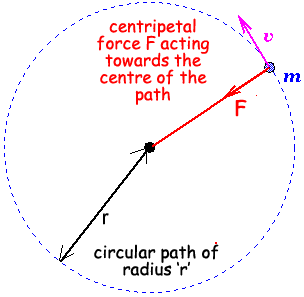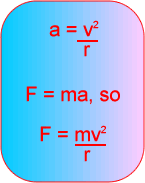    |
||||

Circular Motion |
||||
|
Rotation around a fixed axis of a three-dimensional body involves circular motion too, but at GCSE and A level questions are restricted to simple uniform circular motion. Circular motion involves the constant changing of velocity (even if the speed is constant the direction is changing all of the time). This means that it involves the acceleration of the moving object. Acceleration is evidence of a force acting. That force is called Circular motion is accelerated motion even if the speed is constant, because the object's velocity vector is constantly changing direction. The centripetal force increases with the size of the mass and the magnitude of the speed of the rotation. It decreases as the radius of the circlular path travelled increases. What provides the centripetal force?
The radius of the turning circleTo make an object take a 'tight cirular path' you have to put in a big force - to change the direction a big mass is travelling in takes a big force and to make an object that is travelling fast take a circular path requires a big force.
This film clip shows how altering the radius of a spinning object affects it speed of rotation
|
||||
 |
||||


 the centripetal force. It pulls the moving object towards the center of the circular orbit. Without this acceleration, the object would move inertially in a straight line, according to
the centripetal force. It pulls the moving object towards the center of the circular orbit. Without this acceleration, the object would move inertially in a straight line, according to 
